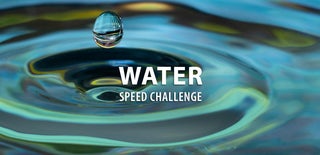Introduction: Visualize Sound Using Water | Cymatics
Cymatics can be termed as a phenomenon where in a surface is vibrated and the regions of maximum and minimum can be visualized using a thin layer of particles, paste or liquid. The particles settle over minima creating mesmerizing patterns.
Lets build one system to visualize the patterns using water.
Do watch the video to see it in action.
Step 1: The Idea
To get the patterns we need to oscillate the plate where water will be placed and to do so we can use a speaker which uses electrical pulses to oscillate.
We need an amplifier to amplify the signals coming from signal generator.
A phone or a laptop can generate the required signals.
We will use water to observe the patterns.
Cone of the speakers are not horizontal nor water resistance so we will 3D print a support which will placed over speaker and the plate will be coupled to the cone of speaker using a single rod. This way the vibrations from speaker can transmitted to plate.
The support will be attached to speaker using nuts and bolts and for extra stability we will string the plate to an overhang.
Step 2: Supplies
primary:
4 ohm 3” speaker link
TDA7297 amplifier module link
12V 2A power supply link
M4 6mm nut bolts X 8
3D printer/ 3D printing service
phone/laptop (Signal generator)
Audio jack to headers
Water
Secondary:
Soldering iron
Threads
Water sealant
Screw driver
Candle/ lighter
Needle
As the TDA7297 module takes audio input through male headers and generally a computer has a audio jack, so soldering a male audio jack to female headers would do the job.
Step 3: 3D Prints
Print the parts in standard printer settings that is 0.4mm nozzle, 0.2mm layer height and PLA material.
Tolerance set while designing was 0.1mm considering no relative motion and static structure. Such a low tolerance was set on purpose because if the tolerance is too high then the parts will start to wobble when vibrated leading to an unstable system.
I used FreeCAD to design the parts.
Step 4: Test: Water Proofing
In the design there are areas where bridging takes place and sometimes this can result in gaps between the layer from which water can leak easily.
To water proof the areas we need a water sealant.
Cheapest water I could find is whitener - the one used for stationary purpose. This works great when dried up preventing water form leaking out.
Step 5: Assembly
Time to assemble everything.
Firstly we will increase the size of holes on 3D prints.
- Best way to do is to use a pointed tip solder iron.
- Let solder iron heat enough.
- Gently circle around inner perimeter of the hole about 5 revolutions is enough.
- Doing so will melt the print enough to fit the parts firmly.
Now insert the hex nut in hex cavity, if they don't go enlarge the hole using solder iron.
Screw the stand with hex nut inserted. to the speaker. Make sure the stand faces upwards.
Hold the central shaft over the cone of speaker and place the flex plate over the central shaft.
Screw the flex plate to stand.
Now place the circular plate over central stand.
Step 6: Test: Wobble
Note: You can skip following 2 steps if you don't experience following problems.
Due to curved surface of speaker the central shaft slips from its intended position when vibrated. To overcome this issue a double tape can be used to stick the central shaft to speaker.
- Cut a circle of diameter 15mm of double tape.
- Stick it to the central part of speaker cone.
- Now peel off the protective over of double tape and place the central shaft firmly.
- Screw the flex plate to stand
Step 7: Test: Stability
If by mistake the holes, particularly of flex plate get too widen, then circular plate may not be able to maintain horizontal position all the time. A small off balance can tilt the circular plate over.
This happens because only a single member, central shaft holds the circular plate. So we need more members to stabilize the plate.
We will attach four threads to circular plate, symmetrically. These threads will attached to over hang above.
- Make four holes in walls using heated needle.
- Needle can be heated over lighter or candle.
- Cut 4 threads of equal length.
- Knot them around the hole.
- Find a over hang and stick the threads
- Make sure the length of string and distance of over hang is just enough to support the circular plate and the vibrations can be received from central shaft.
Step 8: Connections
TDA7297 is dual channel amplifier. We will utilize only single channel.
There are 3 header pins on the module. Starting from left GND, IN1, IN2. Signal from IN1 will be amplified and provided to left screw terminal and signal form IN2 will be amplified and provided to right screw terminal as seen from front.
Any works work for us, but make sure you use respective screw terminal.
- Connect speaker to amplifier using screw terminals
- Connect audio jack to header cable to amplifier
- Plug audio jack to computer
- And power the amplifier with wall adapter using DC jack.
Step 9: Lets Generate Patterns!
Our system is more responsive over a frequency range of 40 - 90 Hz.
You can use this to generate audio signals of various waveforms and characteristics.
And we are done! Plug in, drive the speaker and admire the mesmerizing patterns generated.

First Prize in the
Water Speed Challenge

















